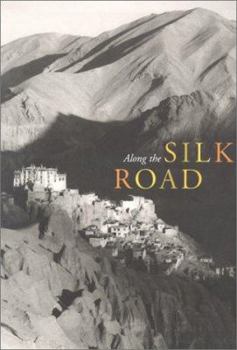Along the Silk Road
(Book #6 in the Asian Art & Culture Series Series)
In 1998 renowned cellist Yo-Yo Ma founded the Silk Road Project, Inc., a nonprofit organization devoted to the living arts of peoples of traditional Silk Road lands. One of the major components of... This description may be from another edition of this product.
Format:Paperback
Language:English
ISBN:0295981822
ISBN13:9780295981826
Release Date:January 2002
Publisher:University of Washington Press
Length:144 Pages
Weight:1.40 lbs.
Dimensions:0.5" x 7.7" x 11.3"
Customer Reviews
2 ratings
Picture the Silk Road
Published by Thriftbooks.com User , 20 years ago
Even without the essays, ALONG THE SILK ROAD would be a visually fascinating book. The numinous photographs by Kenro Izu are art in themselves, and I looked at all the other pictures, too, before reading the text. The great variety has allowed the designer to create a book that is dynamic on the page, and the pictures themselves show everything from ancient art objects to present-day Uyghur street musicians, from landscape to Buddhist imagery on silk. They catch something of the scope of time, geography, and cultural sweep that the Silk Road Project is addressing in many ways. I thought the variety of articles worked very well, too: interview, personal reflection, travelogue, and sound scholarship with a light touch. The different voices and topics make clear that the project has room for many approaches to exploring the contacts, differences, and fusions of a vast region that has for eons been bound up in all sorts of exchanges and reciprocal influences, most of which I knew nothing about until I read this book. It's a great introduction to what a deeply humane America artist, Yo-yo Ma, has been up to recently, and more importantly to a part of the world that has stimulated him and his fellow artists. As the recent events in Afghanistan and Iraq have demonstrated, our fate is bound up with a part of the world that most of us don't know enough about. The good news is that learning about the region can set you thinking all sorts of new and exciting things.
Trading Cultures
Published by Thriftbooks.com User , 21 years ago
The world's two largest Buddhist sculptures were once at Bamiyan, Afghanistan. There, travelers found not only lodgings and supplies but also Buddhist instruction. It was one of the stops on the Silk Road, running from E Asia to the Mediterranean cities of Aleppo, Antioch, Sidon and Tyre.19th-century German explorer Baron Ferdinand von Richthofen thought up the term Silk Road. But the road was much older than that, at its busiest from about 2,200 years ago, until about 600 years ago. It was kept up, for farflung trade in carved ivory cosmetic boxes, cotton, gems, gold ornaments, horses, incense, jade, lacquer ware, linens, Roman glass, silk, spices, tea and woolens. But it also was a way for culture and know-how to be swapped. For example, from the east westward, the road spread knowing how to smelt metal and make cast iron, glass, gunpowder and steel.Particularly sections on cultural trading in music I found most interesting. Sometimes it's not obvious why we need to know history. But in this case it's long ago, but not long gone. Ancient musical influences still are seen today. For example, qin opera in Shaanxi province has happy tunes, which is common in Chinese music. But it also has sorrowful tunes, which isn't common. They're based on a scale of 8 pitches in the octave. They're also sung in a shouting style. Neither's common in Chinese music. But both are, in the music of Central Asia, where they came from during Silk Road times.ALONG THE SILK ROAD also brought up a musical mystery. The first town at which east-bound Silk Road travelers stopped inside China was Dunhuang. There, merchants, pilgrims and traders built Buddhist temples inside the rock, in the Mogao caves, about 1,400-1,500 years ago. They also had painted about 45,000 wall paintings. Many dealt with the Western Pure Land, the supposed source of all good music. So some even had music scores, in ancient notation. Modern music scholars feel they know the pitches. They don't agree on rhythm and meter.However, the money needed for further research may be out there. In 1998 world-famous cellist Yo-Yo Ma founded the Silk Road Project, Inc. The project's a nonprofit foundation to help artists nowadays in Silk Road lands. It's most known, since winter 2001, for paying for music works played in concerts and festivals around the world.Elizabeth Ten Grotenhuis has edited a clear, nicely illustrated book. She sets the stage for the more in-depth CAVE TEMPLES OF MOGAO by Roderick Whitfield. Her sections on music are invaluable for THE HUNDRED THOUSAND FOOLS OF GOD: MUSICAL TRAVELS IN CENTRAL ASIA by Theodore Levin and CARAVAN TO AMERICA: LIVING ARTS OF THE SILK ROAD by John S Major and Betty J Belanus.




